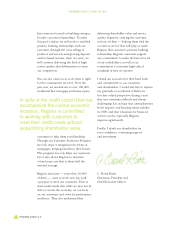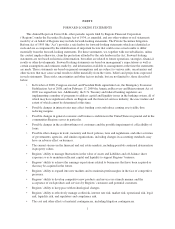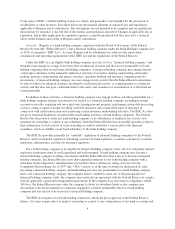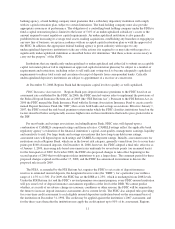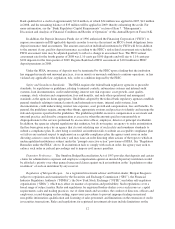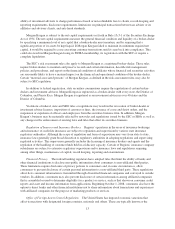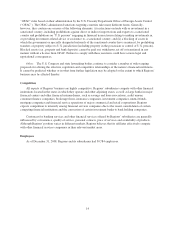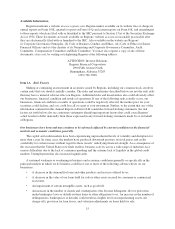Regions Bank 2008 Annual Report Download - page 16
Download and view the complete annual report
Please find page 16 of the 2008 Regions Bank annual report below. You can navigate through the pages in the report by either clicking on the pages listed below, or by using the keyword search tool below to find specific information within the annual report.types of financial institutions such as broker-dealers, investment advisors and insurance companies, and
strengthened the ability of the U.S. Government to help prevent, detect and prosecute international money
laundering and the financing of terrorism. The principal provisions of Title III of the USA PATRIOT Act require
that regulated financial institutions, including state member banks: (i) establish an anti-money laundering
program that includes training and audit components; (ii) comply with regulations regarding the verification of
identity of any person seeking to open an account; (iii) take additional required precautions with non-U.S. owned
accounts; and (iv) perform certain verification and certification of money laundering risk for their foreign
correspondent banking relationships. Failure of a financial institution to comply with the USA PATRIOT Act’s
requirements could have serious legal and reputational consequences for the institution. Regions’ banking,
broker-dealer and insurance subsidiaries have augmented their systems and procedures to meet the requirements
of these regulations and will continue to revise and update their policies, procedures and controls to reflect
changes required by the USA PATRIOT Act and implementing regulations.
U.S. Treasury Capital Purchase Program. Pursuant to the U.S. Department of the Treasury’s (the “U.S.
Treasury”) Capital Purchase Program (the “CPP”), on November 14, 2008, Regions issued and sold to the U.S.
Treasury in an offering exempt from registration under Section 4(2) of the Securities Act of 1933, (i) 3.5 million
shares of Regions’ Fixed Rate Cumulative Perpetual Preferred Stock, Series A, par value $1.00 and liquidation
preference $1,000 per share ($3.5 billion aggregate liquidation preference) (the “Series A Preferred Stock”) and
(ii) a warrant (the “Warrant”) to purchase 48,253,677 shares of Regions’ common stock, at an exercise price of
$10.88 per share, subject to certain anti-dilution and other adjustments for an aggregate purchase price of $3.5
billion in cash. The securities purchase agreement, dated November 14, 2008, pursuant to which the securities
issued to the U.S. Treasury under the CPP were sold, limits the payment of dividends on Regions’ common stock
to the current quarterly dividend of $0.10 per share without prior approval of the U.S. Treasury, limits Regions’
ability to repurchase shares of its common stock (with certain exceptions, including the repurchase of our
common stock to offset share dilution from equity-based compensation awards), grants the holders of the Series
A Preferred Stock, the Warrant and the common stock of Regions to be issued under the Warrant certain
registration rights, and subjects Regions to certain of the executive compensation limitations included in the
Emergency Economic Stabilization Act of 2008.
FDIC Temporary Liquidity Guarantee Program. Regions and Regions Bank have chosen to participate in
the FDIC’s Temporary Liquidity Guarantee Program (the “TLGP”), which applies to, among others, all U.S.
depository institutions insured by the FDIC and all United States bank holding companies, unless they have opted
out. Under the TLGP, the FDIC guarantees certain senior unsecured debt of Regions and Regions Bank, as well
as non-interest bearing transaction account deposits at Regions Bank. Under the transaction account guarantee
component of the TLGP, all non-interest bearing transaction accounts maintained at Regions Bank are insured in
full by the FDIC until December 31, 2009, regardless of the standard maximum deposit insurance amounts.
Under the debt guarantee component of the TLGP, the FDIC will pay the unpaid principal and interest on an
FDIC-guaranteed debt instrument upon the uncured failure of the participating entity to make a timely payment
of principal or interest. On December 11, 2008, Regions Bank issued and sold $3.5 billion aggregate principal
amount of its senior bank notes guaranteed under the TLGP. Regions Bank issued and sold an additional $250
million aggregate principal amount of guaranteed senior bank notes on December 16, 2008. Neither Regions nor
Regions Bank is permitted to use the proceeds from the sale of securities guaranteed under the TLGP to prepay
any of its other debt that is not guaranteed by the FDIC.
Comprehensive Financial Stability Plan of 2009. On February 10, 2009, Treasury Secretary Timothy
Geithner announced a new comprehensive financial stability plan (the “Financial Stability Plan”), which builds
upon existing programs and earmarks the second $350 billion of unused funds originally authorized under the
Emergency Economic Stabilization Act of 2008.
The major elements of the Financial Stability Plan include: (i) a capital assistance program that will invest
in convertible preferred stock of certain qualifying institutions, (ii) a consumer and business lending initiative to
fund new consumer loans, small business loans and commercial mortgage asset-backed securities issuances,
6


